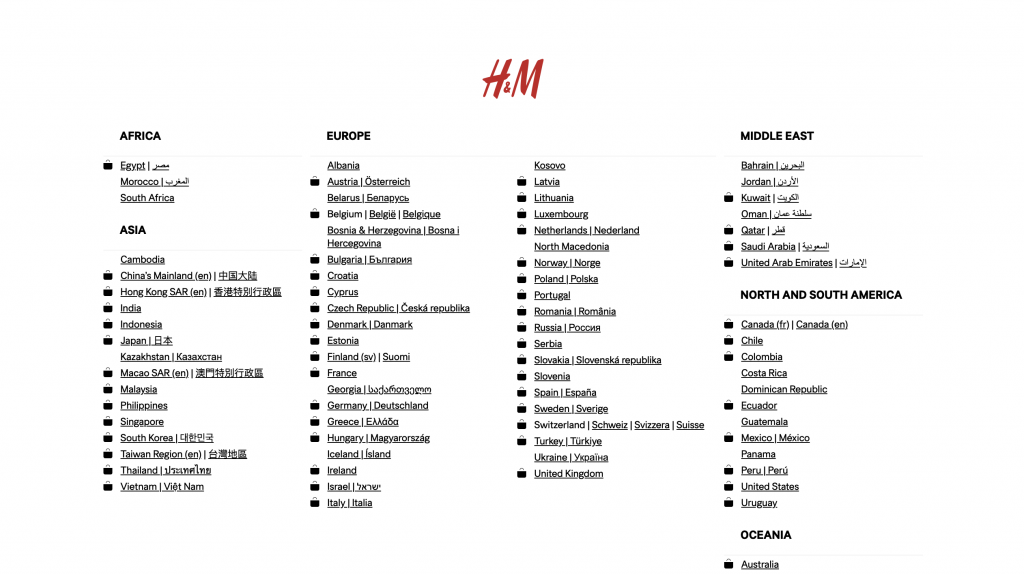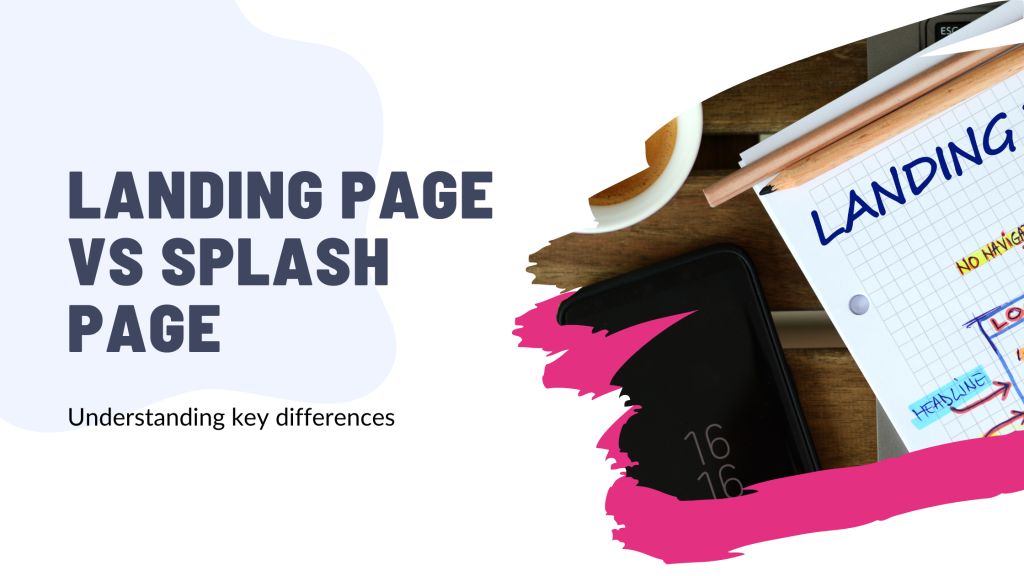In the bustling world of web design, every click counts! Whether you’re launching a new product or sharing exciting news, understanding the right tools at your disposal is crucial.
You’ve probably heard of landing pages and splash pages, but do you know the key differences between them? Each serves a unique purpose and can significantly impact your online success.
In this post, we’ll dive into the vibrant world of landing pages and splash pages. Get ready to discover how to captivate your audience and boost conversions like never before!
Let’s unlock the secrets together!

If you need help creating your website, don’t hesitate to contact us. Click here.
What is a Landing Page?

When you hear the term landing page, think of it as the ultimate landing spot for your visitors. It’s a standalone web page designed with one specific goal in mind: to get your audience to take action.
Whether it’s signing up for a newsletter, downloading an eBook, or making a purchase, the primary purpose of a landing page is to drive conversions.
According to research, businesses that use landing pages effectively can increase their conversion rates by up to 300%! That’s a game changer, right?
A well-crafted landing page removes distractions and focuses on what matters most—getting your visitors to act. Unlike other web pages filled with clutter and options, a landing page is about simplicity and clarity.
You want your audience to know exactly what to do next, and that’s where the magic happens!
Key Features of Landing Pages
To create an effective landing page, there are a few key features you should include:
- Clear call-to-action (CTA): This is your opportunity to tell visitors what you want them to do. Use action-oriented language like “Sign Up Now” or “Get Your Free Trial” to motivate them!
- Focused content tailored to a specific audience: Your messaging should resonate with the needs and interests of your target audience. Know who they are and what they’re looking for, and speak directly to them.
- Minimal distractions: A successful landing page keeps it simple. Avoid navigation links and unnecessary information that could divert attention from your main goal. The less clutter, the better!
By incorporating these elements, you’ll be well on your way to designing a landing page that not only attracts visitors but also converts them into loyal customers.
What is a Splash Page?

A splash page serves as a captivating introduction to your website or a specific campaign. Think of it as a digital doorway, designed to engage visitors the moment they arrive.
Unlike landing pages that focus on conversions, splash pages are typically used to grab attention and create intrigue.
Their primary purpose is to make a strong first impression, often featuring promotions, announcements, or even just a stylish welcome that sets the tone for what’s to come.
Splash pages can be particularly effective when you want to highlight something special, such as a seasonal campaign or a new product launch.
Key Features of Splash Pages
To create an eye-catching splash page, consider incorporating these key features:
- Attention-grabbing visuals or animations: Splash pages thrive on bold visuals! Whether it’s a striking image, an animated graphic, or a video background, the goal is to capture your visitors’ attention immediately. Remember, you have just a few seconds to make an impact!
- Brief content that leads to further action: Keep your message short and sweet. A splash page should provide just enough information to entice visitors without overwhelming them. Use concise language that encourages them to click through to your main content.
- Often used for promotional purposes or announcements: Use splash pages to highlight limited-time offers, upcoming events, or important news. This creates a sense of urgency that can prompt visitors to take action right away.
By leveraging these features effectively, you can create splash pages that not only draw in visitors but also encourage them to dive deeper into your website.
Key Differences Between Landing Pages and Splash Pages
Here are some key differences between landing pages and splash pages.
Structure and Design

When it comes to structure and design, landing pages and splash pages serve different purposes, and this is reflected in their layouts.
A landing page is typically clean and focused, often featuring a single column layout that guides the visitor’s eye directly to the call-to-action (CTA).
The design is minimalist, with limited distractions, allowing the visitor to concentrate solely on the action you want them to take—whether it’s signing up for a newsletter or making a purchase.
In contrast, a splash page often incorporates more visual elements, including bold images, animations, or videos, to create an immediate impact. Its layout may be more dynamic, sometimes covering the entire screen and offering multiple paths for user interaction.
However, this also means splash pages can introduce distractions if not designed carefully. The key here is to balance visual appeal with user experience; you want to engage your audience without overwhelming them.
Goals and Metrics
The goals of landing pages and splash pages differ significantly. The primary goal of a landing page is to drive conversions—turning visitors into leads or customers.
This means that every element on the page should be geared toward encouraging that specific action. For example, if your goal is to get users to fill out a form, that CTA will be prominently displayed, with supporting text that emphasizes the benefits of taking that action.
On the other hand, the goal of a splash page is usually to capture attention and create interest. While it may lead to further actions, its main purpose is to engage the visitor initially rather than convert them right away.
A splash page might encourage users to enter a promotion or learn more about a new product but is not primarily focused on immediate conversion.
To measure success, it’s crucial to look at different metrics for each type of page. For landing pages, key metrics include:
| Landing Pages | Splash Pages |
|---|---|
| Conversion rate: This measures the percentage of visitors who complete the desired action. | Bounce rate: This tells you how many visitors leave your site after viewing only the splash page, which can indicate whether your splash page effectively engages users. |
| Click-through rate (CTR): This indicates how many visitors clicked on your CTA compared to how many viewed the page. | Time on page: This metric shows how long visitors are staying on your splash page before moving on, giving insights into engagement levels. |
When to Use a Landing Page or a Splash Page
Knowing when to use a landing page or a splash page can significantly impact your success in achieving your online goals.
Each has its own ideal scenarios, and understanding these can help you make the best choice for your business.
| Use Landing Pages | Use Splash Pages |
|---|---|
| Product Launches: When you’re introducing a new product, a dedicated landing page can effectively showcase its features, benefits, and pricing. This focused approach encourages visitors to make a purchase or sign up for more information. | Seasonal Promotions: If you have a special offer for the holidays or a limited-time discount, a splash page can create excitement and urgency. It allows you to draw attention to the promotion right away. |
| Sign-Ups and Lead Generation: If your goal is to build an email list or generate leads, landing pages are perfect. You can create a compelling offer, such as a free trial or an exclusive eBook, and direct visitors to take action. | Teaser Campaigns: When you want to build anticipation for an upcoming product or event, a splash page can effectively set the stage. Use engaging visuals and brief content to spark interest without giving everything away. |
| Event Registration: For webinars, workshops, or conferences, a landing page can provide all the details and motivate users to register quickly. |
The key here is to keep it simple and engaging. Splash pages should not overwhelm visitors with too much information; instead, focus on creating a memorable first impression that encourages them to explore further.
Use bold visuals and clear messaging to guide them toward their next action.
Practical Tips for Creating Effective Landing and Splash Pages
Creating effective landing and splash pages requires a thoughtful approach to design and content. Here are some best practices to keep in mind:
- Use Compelling Headlines and Visuals: Your headline is the first thing visitors will see, so make it count! Craft a headline that clearly conveys the value of what you’re offering. Pair it with eye-catching visuals—whether it’s a stunning image, a video, or an engaging graphic—to capture attention right away.
- Importance of Mobile Optimization: In today’s digital landscape, many users access websites from their mobile devices. Ensure that your landing and splash pages are fully optimized for mobile. This means responsive design that adjusts seamlessly to different screen sizes, fast loading times, and easy navigation. A mobile-friendly page will enhance user experience and keep visitors engaged, regardless of the device they are using.
Tools and Resources

To help you create stunning landing and splash pages without the need for extensive design skills, consider using user-friendly tools. One highly recommended option is Landingi.
- Landingi: This platform allows you to create beautiful landing pages and splash pages with ease. It offers a drag-and-drop interface, a variety of templates, and customizable elements that make it simple to design pages that convert. Plus, Landingi provides tools for A/B testing, helping you optimize your pages based on real user data.
Other options to explore include:
- Unbounce: Known for its powerful features focused on conversion optimization, Unbounce helps create high-performing landing pages tailored to your goals.
- Instapage: This platform offers a wide range of templates and easy integration with various marketing tools, making it ideal for businesses looking to streamline their landing page creation process.
By leveraging these tools and following best practices for design and content, you can create effective landing and splash pages that not only attract visitors but also encourage them to take action.

If you need help creating your website, don’t hesitate to contact us. Click here.
Conclusion
In the world of web design, understanding the differences between landing pages and splash pages is essential for effectively engaging your audience and achieving your goals. Remember, landing pages are all about driving conversions with focused content and a clear call-to-action, while splash pages serve as eye-catching introductions that create initial interest. By applying the best practices we’ve discussed—such as using compelling visuals, optimizing for mobile, and leveraging powerful tools like Landingi—you can create pages that truly resonate with your visitors.
If you need assistance with implementing these strategies or designing your own landing or splash pages, we’re here to help! Feel free to reach out through our contact form, or connect with us on Instagram or Facebook. Let’s bring your web design vision to life together!

